Health Club Business Plan
Corporate Fitness will serve Seattle-area businesses, helping them become more productive while lowering their costs.
Our business is based on two simple facts:
1. Healthy employees are more productive than chronically ill employees.
2. Preventing injuries or illnesses costs less than treating them after they occur.
At Corporate Fitness, we tie worker productivity directly to the health care issue. We believe that traditional approaches to the health care crisis are misdirected. These efforts are reactive, waiting until after the worker becomes ill or injured and then paying for treatments. Our approach, emphasizing prevention and good health promotion, is proactive.
By helping employees change behavior patterns and choose healthier lifestyles, Corporate Fitness will lower companies’ health care expenditures and increase worker productivity. Expenditures will decrease due to reduced medical insurance premiums, absenteeism, turnover rates, worker’s compensation claims, tardiness, and hospital stays.
The state of America’s health care crisis, combined with demographic changes, threatens to exacerbate the crisis and erode worker productivity. These factors, along with local competition, signal a favorable opportunity in this market. We believe the time is right for Corporate Fitness.
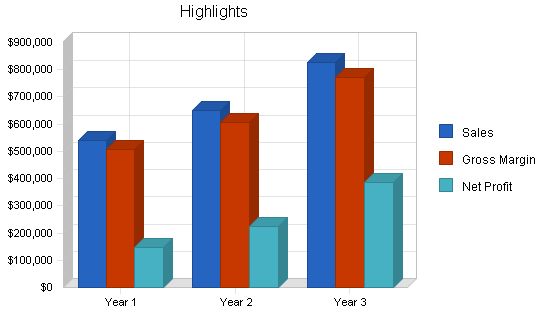
1.1 Objectives:
– Provide wellness strategies/programs to downtown Seattle businesses.
– Establish working relationships with 20 companies by the end of year one.
– Expand Corporate Fitness into Portland, Oregon by the end of year two.
1.2 Keys to Success:
– Marketing services to companies and individuals.
– Recruiting experienced managerial talent.
– Dedication and hard work of the founders.
– Increasing productivity.
– Lowering overall costs.
1.3 Mission:
– Corporate Fitness is a health service that helps businesses and individual workers achieve good health. This creates advantages for both employers and employees through improved self-esteem, self-motivation, and measurable benefits.
– Corporate Fitness believes that healthy employees are more productive and efficient. It provides wellness strategies/programs to downtown Seattle businesses, promoting health and exercise-related activities to facilitate positive lifestyle changes in the workforce. The company was founded in Seattle by three directors.
2.1 Company Ownership:
– Corporate Fitness is a privately held corporation. The ownership is divided among the three founders:
– Dave Jensen – 40%
– Steve Perkins – 30%
– Robert Gomez – 30%
2.2 Start-up Summary:
– Start-up will require $300,000 of capital, with $200,000 provided by the founders and their families, and the remaining $100,000 as a loan.
– Approximately $140,000 will be allocated to leasehold improvements and $75,000 to equipment.
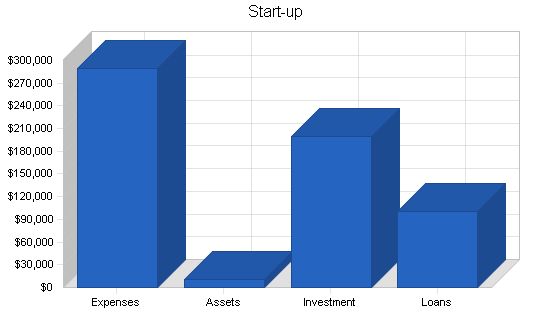
Start-up Funding
Start-up Expenses to Fund: $290,000
Start-up Assets to Fund: $10,000
Total Funding Required: $300,000
Assets
Non-cash Assets from Start-up: $0
Cash Requirements from Start-up: $10,000
Additional Cash Raised: $0
Cash Balance on Starting Date: $10,000
Total Assets: $10,000
Liabilities and Capital
Liabilities
Current Borrowing: $0
Long-term Liabilities: $100,000
Accounts Payable (Outstanding Bills): $0
Other Current Liabilities (interest-free): $0
Total Liabilities: $100,000
Capital
Planned Investment
Investor 1: $80,000
Investor 2: $60,000
Investor 3: $60,000
Additional Investment Requirement: $0
Total Planned Investment: $200,000
Loss at Start-up (Start-up Expenses): ($290,000)
Total Capital: ($90,000)
Total Capital and Liabilities: $10,000
Total Funding: $300,000
Start-up
Requirements
Start-up Expenses
Legal: $1,250
Stationery etc.: $1,000
Brochures: $800
Insurance: $5,000
Rent: $58,000
Expensed Equipment: $75,000
Utilities: $6,500
Leasehold improvements: $140,000
Other: $2,450
Total Start-up Expenses: $290,000
Start-up Assets
Cash Required: $10,000
Other Current Assets: $0
Long-term Assets: $0
Total Assets: $10,000
Total Requirements: $300,000
2.3 Company Locations and Facilities
Corporate Fitness headquarters are located within the first club in downtown Seattle. Upon expansion, offices will be moved to a different location, not within any individual club.
Services
Business ratios for Corporate Fitness indicate strong financial growth and impressive investment opportunities, making expansion and development possible.
3.1 Service Description
Corporate Fitness provides wellness strategies/programs to businesses in downtown Seattle. A wellness strategy combines health-promotion and exercise-related activities to facilitate positive lifestyle changes in a company’s workforce.
Corporate Fitness will work with a company’s senior management to develop a mission statement for its wellness program. Employees will undergo a health-risk analysis and design a personalized health program with a health professional.
Corporate Fitness will furnish employee progress reports to senior management to carry out the incentive program and monitor changes in the behavior of the workforce.
3.2 Competitive Comparison
Corporate Fitness is not primarily a health club like most competitors but focuses on health care cost management. The organization works with client companies to implement wellness strategies. Exercise is only one aspect of overall wellness, and many employees benefit from these strategies without visiting the fitness facility.
Corporate Fitness has a vested interest in each individual member of every wellness program, unlike many competitors. This service includes following up and monitoring individuals.
3.3 Fulfillment
Fitness machines are purchased from exercise equipment distributors, while medical equipment is bought from a reputable supply company.
Market Analysis Summary
In 1991, the U.S. medical bill was $738 million, with businesses paying 30 percent. Recent studies show high returns on investments in wellness programs for various companies. For example, General Electric’s aircraft engines division saves $1 million per year, and Traveler’s Insurance Company reported savings of $7.8 million in 1991 attributable to its wellness programs.
Important demographic changes in America emphasize the importance of worker productivity in the coming decades.
– 16 million new jobs will be created by the year 2000, but there will only be 14 million workers to fill them.
– By 1995, women will comprise one-third of the workforce, increasing to one-half by the year 2000.
– An estimated 80 percent of jobs to be filled in the immediate future will require more than a high-school education. However, only 74 percent of Americans finish high school, and only 67 percent graduate with adequate skills.
– The number of skilled workers available to fill new jobs is decreasing, leading to more severe competition for labor. Therefore, the health and productivity of each employee are crucial to a company’s success.
4.1 Market Segmentation
The market for corporate fitness is not particularly segmented, as potential customers include all downtown businesses offering employees medical benefits, experiencing escalating health care costs, and wishing to manage those costs effectively.
Corporate Fitness, however, segments its services for individual organizations. The company works with senior management to develop mission statements and provide incentive plans, and with employees to design personalized health and fitness programs.
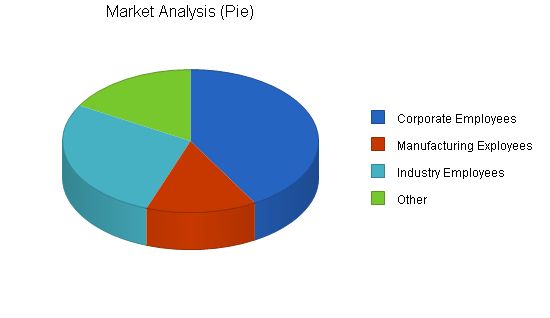
Market Analysis
Year 1 Year 2 Year 3 Year 4 Year 5 CAGR
Potential Customers Growth
Corporate Employees 35% 750 1,013 1,368 1,847 2,493 35.03%
Manufacturing Employees 15% 250 288 331 381 438 15.05%
Industry Employees 25% 500 625 781 976 1,220 24.98%
Other 15% 300 345 397 457 526 15.07%
Total 26.96% 1,800 2,271 2,877 3,661 4,677 26.96%
4.2 Service Business Analysis
Several small fitness facilities currently operate in the downtown area, none of which cater their services to corporations. These organizations are primarily exercise facilities with little emphasis on personalizing individual plans to improve working performance.
4.2.1 Main Competitors
The three main competitors for Corporate Fitness are:
– YMCA: targets lower-income families and/or students seeking accessible and affordable fitness facilities.
– Gold’s Gym: targets motivated and dedicated individuals who work out five to seven times per week.
– Better Bodies: targets casual fitness-seekers who desire status and recognition but do not work out at a high intensity.
4.2.2 Distributing a Service
Few fitness centers are located in downtown Seattle, while the majority are found in suburban neighborhoods and shopping complexes. Downtown centers are close to professional centers containing restaurants, parks, and recreational activities. In suburban locales, these establishments are often found near grocery stores, restaurants, and retail stores.
4.2.3 Business Participants
Participants in the fitness industry include national, regional, and local organizations. Nationally, companies like Gold’s Gym and the YMCA offer exercise facilities and training programs. Regionally, firms like Better Bodies and Bally’s provide comparable services, while locally, privately-owned businesses offer similar services to exercise-seekers.
Strategy and Implementation Summary
Corporate Fitness’ strategy aims to raise worker productivity and lower overall costs for businesses. The most logical approach to these factors is through a healthy workforce. Companies that implement wellness programs with Corporate Fitness will be encouraged to consider the effects of these programs. One marketing goal is to persuade traditionally managed companies that wellness can work for them.
By tailoring services and developing customized programs, Corporate Fitness will build a reputation for quality and customer service.
5.1 Milestones
Sample Milestones topic text.
The milestones table and chart provide specific details about program activities that should occur during the year. Each milestone includes its manager, starting date, ending date, and budget. Implementation will be tracked against the plan, with reports on timely completion.
To develop effective business strategies, perform a SWOT analysis of your business. Use our free guide and template to learn how.
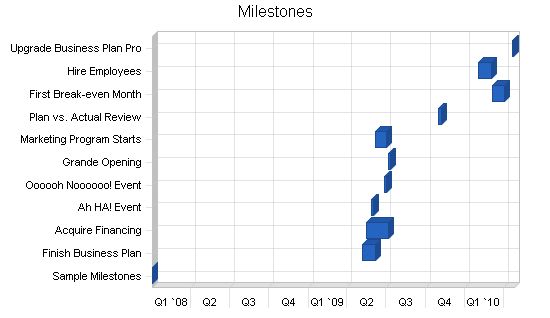
Milestones:
Milestone Start Date End Date Budget Manager Department
Sample Milestones 1/4/2008 1/4/2008 $0 ABC Department
Finish Business Plan 5/7/2009 6/6/2009 $100 Dude LeGrande Fromage
Acquire Financing 5/17/2009 7/6/2009 $200 Dudette Legumers
Ah HA! Event 5/27/2009 6/1/2009 $60 Marianne Bosses
Oooooh Noooooo! Event 6/26/2009 7/1/2009 $250 Marionette Chèvre deBlâme
Grande Opening 7/6/2009 7/11/2009 $500 Gloworm Nobs
Marketing Program Starts 6/6/2009 7/1/2009 $1,000 Glower Marketeers
Plan vs. Actual Review 11/1/2009 11/8/2009 $0 Galore Alles
First Break-even Month 3/5/2010 4/4/2010 $0 Bouys Salers
Hire Employees 2/1/2010 3/3/2010 $150 Gulls HRM
Upgrade Business Plan Pro 4/22/2010 4/24/2010 $100 Brass Bossies
Totals $2,360
5.2 Marketing Strategy:
Corporate Fitness will target small- to medium-sized businesses in downtown Seattle. The initial task is to convince senior executives of the benefits and needs of wellness programs. This will be achieved by actively building relationships with business professionals who would benefit from this service. Once a strong image is established, Corporate Fitness will use similar strategies to market to larger corporations in Seattle and other expansion areas.
5.2.1 Pricing Strategy:
Corporate Fitness’ service prices are comparable to those of higher-end fitness centers. An employee will pay a $100 monthly fee to access a Corporate Fitness center. Employers will pay an annual fee of $150 for each employee enrolled in the general wellness program, regardless of facility use. The prices reflect the quality of equipment and service.
5.2.2 Promotion Strategy:
After initial promotions through print and media advertisements, Corporate Fitness will rely on word-of-mouth to attract potential clients. Minimal promotional activity will still be used through newspapers, magazines, television, and radio.
5.3 Sales Strategy:
This information was omitted from the sample plan.
5.3.1 Sales Forecast:
Anticipated sales are shown in the accompanying table and chart.
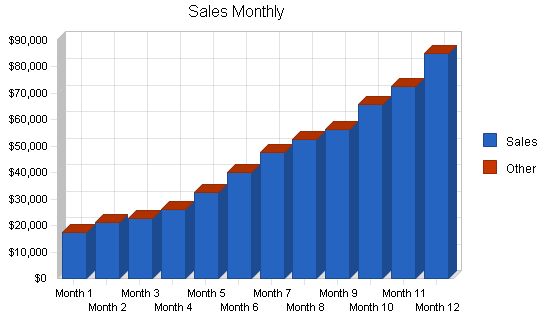
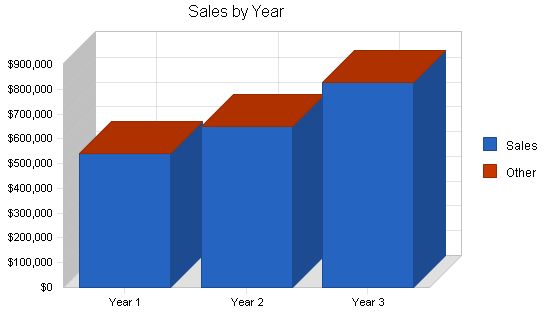
Sales Forecast
| Sales Forecast | |||
| Year 1 | Year 2 | Year 3 | |
| $539,075 | $650,750 | $825,600 | |
| $0 | $0 | $0 | |
| $539,075 | $650,750 | $825,600 | |
| Year 1 | Year 2 | Year 3 | |
| $33,000 | $44,000 | $55,000 | |
| $0 | $0 | $0 | |
| $33,000 | $44,000 | $55,000 | |
Management Summary
Corporate Fitness is a small organization headed by three individuals. The CEO/Director of Sales and Marketing oversees the Director of Health and Wellness Programs and the Director of Finance and Administration. The Director of Health and Wellness Programs supervises the fitness specialists and health educators. The Director of Finance and Administration provides guidance for fitness facility attendants. More director positions will be added as the firm grows.
6.1 Organizational Structure
Corporate Fitness currently has two divisions: "Health and Wellness" and "Finance and Administration." As the company grows, more divisions will be created to meet the increasing demand for services.
6.2 Management Team
– Dave Jensen: CEO and Director of Sales and Marketing. Responsible for providing leadership, direction, and control for all company activities. Completed undergraduate degree at the University of North Carolina and MBA from the University of Texas.
– Steve Perkins: Director of Finance and Administration. Responsible for guiding and directing financial and control activities. Completed undergraduate work at the University of California-Berkeley and received MBA from Vanderbilt University.
– Robert Gomez: Director of Health and Wellness Programs. Responsible for the overall management of the health promotion program. Received undergraduate degree in Exercise and Movement Science from the University of Oregon.
6.3 Management Team Gaps
Corporate Fitness’ management team gaps:
– Lack of experience in the fitness industry.
– Minimal expertise in finance and accounting.
– Strong desire for immediate financial prosperity with little patience for minimal profitability.
6.4 Personnel Plan
Corporate Fitness’ personnel staff requirements:
| Personnel Plan | |||
| Year 1 | Year 2 | Year 3 | |
| $15,000 | $15,000 | $15,000 | |
| $54,000 | $54,000 | $54,000 | |
| $36,000 | $36,000 | $36,000 | |
| $33,000 | $33,000 | $33,000 | |
| $12,000 | $12,000 | $12,000 | |
| $150,000 | $150,000 | $150,000 | |
– Consulting revenue will make up approximately 85 to 90 percent of total revenue, with the rest coming from service revenue.
– Salaries and rent are the major expenses, while depreciation is another significant cost. Constant replacement of fitness, medical, and office equipment will be needed to maintain a competitive edge.
– Salaries and advertising expenses are not likely to increase within the first two years of operation, unless cash flows significantly increase, in order to maintain steady gross margins.
7.1 Important Assumptions
Corporate Fitness’ assumptions:
1. Constantly growing economy without any major recession or boom.
2. No unpredictable changes in fitness, medical, or office equipment.
3. No major national or global events that threaten the stability and health of the country and its citizens.
| General Assumptions | |||
| Year 1 | Year 2 | Year 3 | |
| 1 | 2 | 3 | |
| 3.00% | 3.00% | 3.00% | |
| 10.00% | 10.00% | 10.00% | |
| 25.00% | 25.00% | 25.00% | |
| 0 | 0 | 0 | |
7.2 Key Financial Indicators
The most important financial indicators are net increase in cash and net income. The greater the increase in net cash, the higher the level of financial strength at that point in time.
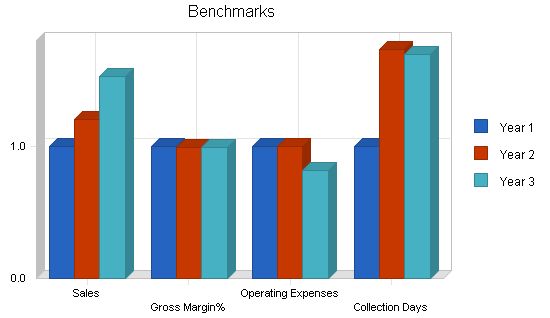
Corporate Fitness computes its break-even point by comparing sales and monthly expenses, as shown in the table below. Sales forecasts indicate that units sold and monthly sales are expected to exceed the break-even point mentioned in the table.
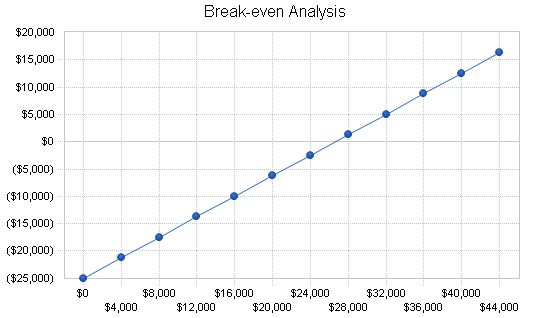
Break-even Analysis:
Monthly Revenue Break-even: $26,683
Assumptions:
– Average Percent Variable Cost: 6%
– Estimated Monthly Fixed Cost: $25,050
7.4 Projected Profit and Loss:
Sales are projected to increase monthly, with first-year annual sales totaling close to half a million dollars. Gross margin is also expected to increase accordingly.
Net profit will increase each month compared to total sales and is predicted to increase from 1995 to 1997.
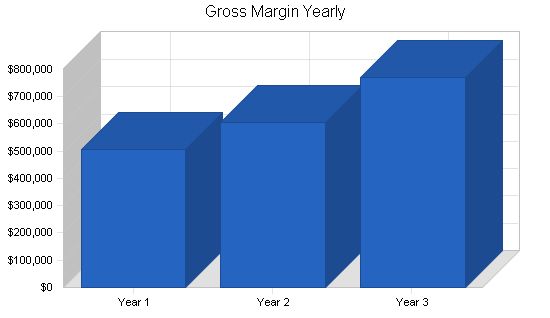
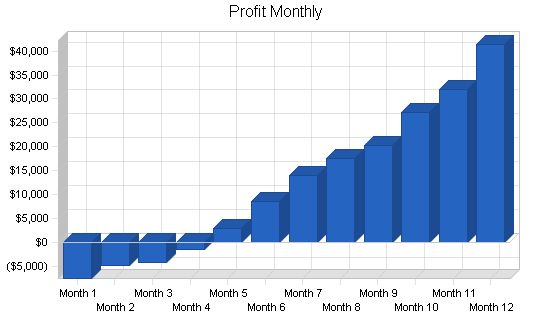
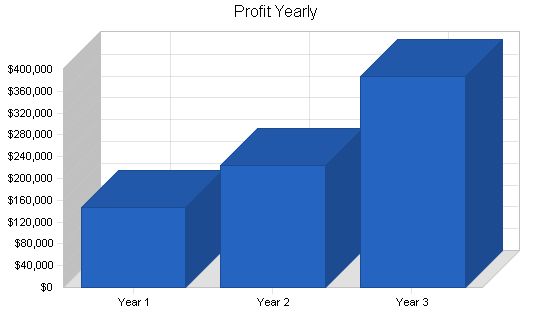
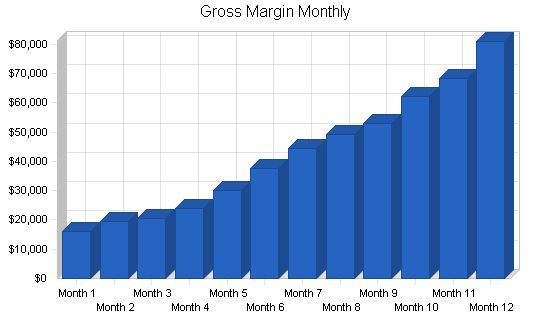
Projected Cash Flow:
Cash flow will increase significantly while expenses remain static. We plan to take a short-term loan to cover receivables and contingencies in month one, repaying it in month 12.
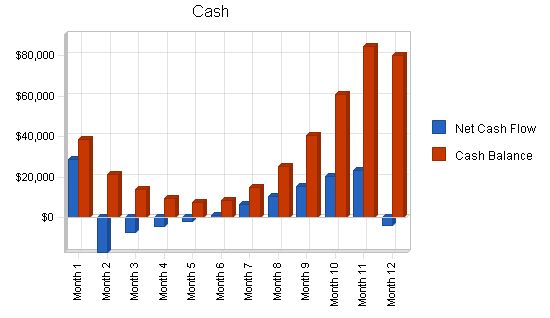
Pro Forma Cash Flow
| Pro Forma Cash Flow | |||
| Year 1 | Year 2 | Year 3 | |
| Cash Received | |||
| Cash from Operations | |||
| Cash Sales | $215,630 | $260,300 | $330,240 |
| Cash from Receivables | $230,395 | $371,174 | $465,179 |
| Subtotal Cash from Operations | $446,025 | $631,474 | $795,419 |
| Additional Cash Received | |||
| Sales Tax, VAT, HST/GST Received | $0 | $0 | $0 |
| New Current Borrowing | $36,000 | $0 | $0 |
| New Other Liabilities (interest-free) | $0 | $0 | $0 |
| New Long-term Liabilities | $0 | $0 | $0 |
| Sales of Other Current Assets | $0 | $0 | $0 |
| Sales of Long-term Assets | $0 | $0 | $0 |
| New Investment Received | $0 | $0 | $0 |
| Subtotal Cash Received | $482,025 | $631,474 | $795,419 |
| Expenditures | Year 1 | Year 2 | Year 3 |
| Expenditures from Operations | |||
| Cash Spending | $150,000 | $150,000 | $150,000 |
| Bill Payments | $206,122 | $277,578 | $280,145 |
| Subtotal Spent on Operations | $356,122 | $427,578 | $430,145 |
| Additional Cash Spent | |||
| Sales Tax, VAT, HST/GST Paid Out | $0 | $0 | $0 |
| Principal Repayment of Current Borrowing | $36,000 | $0 | $0 |
| Other Liabilities Principal Repayment | $0 | $0 | $0 |
| Long-term Liabilities Principal Repayment | $10,000 | $10,000 | $10,000 |
| Purchase Other Current Assets | $0 | $0 | $0 |
| Purchase Long-term Assets | $9,600 | $9,600 | $9,600 |
| Dividends | $0 | $0 | $0 |
| Subtotal Cash Spent | $411,722 | $447,178 | $449,745 |
| Net Cash Flow | $70,303 | $184,295 | $345,675 |
| Cash Balance | $80,303 | $264,599 | $610,273 |
Projected Balance Sheet
The balance sheet indicates that at the end of the first year of operation, net worth will be positive and constantly increasing through the end of 1997.
| Pro Forma Balance Sheet | |||
| Year 1 | Year 2 | Year 3 | |
| Assets | |||
| Current Assets | |||
| Cash | $80,303 | $264,599 | $610,273 |
| Accounts Receivable | $93,050 | $112,326 | $142,507 |
| Other Current Assets | $0 | $0 | $0 |
| Total Current Assets | $173,353 | $376,925 | $752,780 |
| Long-term Assets | |||
| Long-term Assets | $9,600 | $19,200 | $28,800 |
| Accumulated Depreciation | $7,200 | $14,400 | $21,600 |
| Total Long-term Assets | $2,400 | $4,800 | $7,200 |
| Total Assets | $175,753 | $381,725 | $759,980 |
| Liabilities and Capital | Year 1 | Year 2 | Year 3 |
| Current Liabilities | |||
| Accounts Payable | $29,483 | $22,217 | $23,098 |
| Current Borrowing | $0 | $0 | $0 |
| Other Current Liabilities | $0 | $0 | $0 |
| Subtotal Current Liabilities | $29,483 | $22,217 | $23,098 |
| Long-term Liabilities | $90,000 | $80,000 | $70,000 |
| Total Liabilities | $119,483 | $102,217 | $93,098 |
| Paid-in Capital | $200,000 | $200,000 | $200,000 |
| Retained Earnings | ($290,000) | ($143,730) | $79,507 |
| Earnings | $146,270 | $223,238 | $387,375 |
| Total Capital | $56,270 | $279,507 | $666,882 |
| Total Liabilities and Capital | $175,753 | $381,725 | $759,980 |
| Net Worth | $56,270 | $279,507 | $666,882 |
Business Ratios
The following table outlines some of Corporate Fitness’ important business ratios. The final column, Industry Profile, details specific ratios based on the Physical Fitness Facilities industry as classified by the Standard Industry Classification (SIC) code, 7991. These ratios indicate strong financial growth and investment opportunities, making expansion and development very possible.
| Ratio Analysis | ||||
| Year 1 | Year 2 | Year 3 | Industry Profile | |
| Sales Growth | 0.00% | 20.72% | 26.87% | 4.96% |
| Percent of Total Assets | ||||
| Accounts Receivable | 52.94% | 29.43% | 18.75% | 5.74% |
| Other Current Assets | 0.00% | 0.00% | 0.00% | 34.12% |
| Total Current Assets | 98.63% | 98.74% | 99.05% | 39.86% |
| Long-term Assets | 1.37% | 1.26% | 0.95% | 60.14% |
| Total Assets | 100.00% | 100.00% | 100.00% | 100.00% |
| Current Liabilities | ||||
| Accounts Payable | 29.21% | 21.57% | 17.81% | 21.71% |
| Current Borrowing | 0.00% | 0.00% | 0.00% | 29.51% |
| Other Current Liabilities | 0.00% | 0.00% | 0.00% | 48.78% |
| Subtotal Current Liabilities | 29.21% | 21.57% | 17.81% | 51.22% |
| Long-term Liabilities | 67. | |||
| Personnel Plan | |||||||||||||
| Month 1 | Month 2 | Month 3 | Month 4 | Month 5 | Month 6 | Month 7 | Month 8 | Month 9 | Month 10 | Month 11 | Month 12 | ||
| Fitness Center Management | $1,250 | $1,250 | $1,250 | $1,250 | $1,250 | $1,250 | $1,250 | $1,250 | $1,250 | $1,250 | $1,250 | $1,250 | |
| Program Director | $4,500 | $4,500 | $4,500 | $4,500 | $4,500 | $4,500 | $4,500 | $4,500 | $4,500 | $4,500 | $4,500 | $4,500 | |
| Personnel Manager | $3,000 | $3,000 | $3,000 | $3,000 | $3,000 | $3,000 | $3,000 | $3,000 | $3,000 | $3,000 | $3,000 | $3,000 | |
| Health/Fitness Specialists | $2,750 | $2,750 | $2,750 | $2,750 | $2,750 | $2,750 | $2,750 | $2,750 | $2,750 | $2,750 | $2,750 | $2,750 | |
| Attendants | $1,000 | $1,000 | $1,000 | $1,000 | $1,000 | $1,000 | $1,000 | $1,000 | $1,000 | $1,000 | $1,000 | $1,000 | |
| Total People | 0 | 0 | 0 | 0 | 0 | 0 | 0 | 0 | 0 | 0 | 0 | ||
| Total Payroll | $12,500 | $12,500 | $12,500 | $12,500 | $12,500 | $12,500 | $12,500 | $12,500 | $12,500 | $12,500 | $12,500 | $12,500 | |
| Pro Forma Profit and Loss | |||||||||||||
| Month 1 | Month 2 | Month 3 | Month 4 | Month 5 | Month 6 | Month 7 | Month 8 | Month 9 | Month 10 | Month 11 | Month 12 | ||
| Sales | $17,500 | $21,000 | $22,500 | $26,000 | $32,500 | $40,000 | $47,500 | $52,375 | $56,450 | $65,750 | $72,500 | $85,000 | |
| Direct Cost of Sales | $1,500 | $1,500 | $2,000 | $2,000 | $2,500 | $2,500 | $3,000 | $3,000 | $3,500 | $3,500 | $4,000 | $4,000 | |
| Other Costs of Sales | $0 | $0 | $0 | $0 | $0 | $0 | $0 | $0 | $0 | $0 | $0 | $0 | |
| Total Cost of Sales | $1,500 | $1,500 | $2,000 | $2,000 | $2,500 | $2,500 | $3,000 | $3,000 | $3,500 | $3,500 | $4,000 | $4,000 | |
| Gross Margin | $16,000 | $19,500 | $20,500 | $24,000 | $30,000 | $37,500 | $44,500 | $49,375 | $52,950 | $62,250 | $68,500 | $81,000 | |
| Gross Margin % | 91.43% | 92.86% | 91.11% | 92.31% | 92.31% | 93.75% | 93.68% | 94.27% | 93.8% | 94.68% | 94.48% | 95.29% | |
| Expenses | |||||||||||||
| Payroll | $12,500 | $12,500 | $12,500 | $12,500 | $12,500 | $12,500 | $12,500 | $12,500 | $12,500 | $12,500 | $12,500 | $12,500 | |
| Marketing/Promotion | $2,100 | $2,100 | $2,100 | $2,100 | $2,100 | $2,100 | $2,100 | $2,100 | $2,100 | $2,100 | $2,100 | $2,100 | |
| Depreciation | $600 | $600 | $600 | $600 | $600 | $600 | $600 | $600 | $600 | $600 | $600 | $600 | |
| Rent | $5,000 | $5,000 | $5,000 | $5,000 | $5,000 | ||||||||
Hello!
I’m Andrew Brooks, a seasoned finance consultant from the USA and the mind behind phonenumber247.com.
My career is built on a foundation of helping individuals and businesses thrive financially in an ever-changing economic landscape. At phonenumber247.com, my aim is to demystify the complex world of finance, providing clear, actionable advice that can help you navigate your financial journey with confidence. Whether it’s personal finance management, investment strategies, or understanding the nuances of market dynamics, I’m here to share insights and tools that can propel you towards your financial goals.
Welcome to my digital space, where every piece of advice is a step closer to financial clarity and success!
